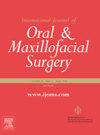用于矢状劈裂臼齿截骨术的斜通道牵引器。
IF 2.2
3区 医学
Q2 DENTISTRY, ORAL SURGERY & MEDICINE
International journal of oral and maxillofacial surgery
Pub Date : 2024-10-16
DOI:10.1016/j.ijom.2024.09.009
引用次数: 0
摘要
使用通道牵引器保护邻近的软组织可以防止矢状劈裂横梁截骨术中出现出血过多等并发症。然而,在通常与咬合平面平行的下颌骨内侧截骨术中,传统通道牵开器的碟形刀片与下颌骨横梁后缘的贴合度较差。因此,我们根据头颅测量数据开发了一种新型通道牵开器,其刀片弯曲角度经过调整。研究人员收集了 339 名日本颌骨畸形患者的侧位头影。根据 Downs-Northwestern 分析法的定义确定了头测地标,并计算了咬合平面和颌骨平面之间的锐角。根据所获得的咬合斜面角度的平均值和中值,在矢状面上将刀片弯曲 70°,以制作成角通道牵引器。在进行内侧截骨时,下颌横梁后缘的啮合增强了其稳定性。此外,由于弯曲方向的原因,用于一侧内侧截骨的成角通道牵引器可用作另一侧外侧截骨的通道牵引器。所提出的成角通道牵引器既稳定,又具有截骨操作的多功能性。本文章由计算机程序翻译,如有差异,请以英文原文为准。
Angled channel retractor for sagittal split ramus osteotomy
Protecting the adjacent soft tissues using a channel retractor prevents complications, such as excessive bleeding, during sagittal split ramus osteotomy. However, the saucer-shaped blade of the conventional channel retractor fits poorly into the posterior border of the mandibular ramus during medial osteotomy, which is typically performed parallel to the occlusal plane. Therefore, a novel channel retractor was developed with an adjusted blade bending angle, based on cephalometric data. The lateral cephalograms of 339 Japanese patients with jaw deformities were collected. Cephalometric landmarks were identified based on the definitions of the Downs–Northwestern analysis, and the acute angle between the occlusal and ramus planes was calculated. Based on the consistent mean and median occlusal ramus angles obtained, the blade was bent at 70° in the sagittal plane to fabricate the angled channel retractor. The engagement at the posterior border of the mandibular ramus during medial osteotomy enhances its stability. Furthermore, owing to the bending direction, the angled channel retractor used for medial osteotomy on one side can be used as a channel retractor for lateral osteotomy on the other side. The proposed angled channel retractor offers both stability and versatility for osteotomy manoeuvres.
求助全文
通过发布文献求助,成功后即可免费获取论文全文。
去求助
来源期刊
CiteScore
5.10
自引率
4.20%
发文量
318
审稿时长
78 days
期刊介绍:
The International Journal of Oral & Maxillofacial Surgery is one of the leading journals in oral and maxillofacial surgery in the world. The Journal publishes papers of the highest scientific merit and widest possible scope on work in oral and maxillofacial surgery and supporting specialties.
The Journal is divided into sections, ensuring every aspect of oral and maxillofacial surgery is covered fully through a range of invited review articles, leading clinical and research articles, technical notes, abstracts, case reports and others. The sections include:
• Congenital and craniofacial deformities
• Orthognathic Surgery/Aesthetic facial surgery
• Trauma
• TMJ disorders
• Head and neck oncology
• Reconstructive surgery
• Implantology/Dentoalveolar surgery
• Clinical Pathology
• Oral Medicine
• Research and emerging technologies.

 求助内容:
求助内容: 应助结果提醒方式:
应助结果提醒方式:


